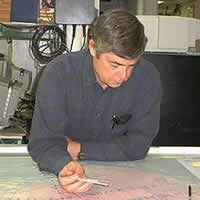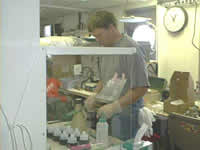| |

Dr. Ed Baker preparing for the next CTD
tows and casts.

Geoff Lebon (Chemical Oceanographer), prepares
chemicals in the Wecoma laboratory.
|
|
Teacher Logbook - R/V Wecoma
Missy
Holzer 's Sealog:
CTD Cruise Day 5
Weather at 1630 hours PDT: Cloudy
skies with winds of 10 knots from the Northwest. Barometric pressure is
1019.8 mb, and the temperature is 58 degrees Fahrenheit. Ocean swells
are 4-5 feet out of the Northwest.
Where to
go, when to go, what to bring are just a few pieces of the picture in
planning for a research cruise. It is up to the leadership and guidance
of the chief scientist to plan the cruise so it's successful in meeting
its objectives, otherwise a tremendous amount of quality data, time, and
money are wasted. The NeMO Cruise is extremely fortunate to have Dr. Ed
Baker, as it's chief scientist, as he possesses the necessary abilities
to orchestrate a research cruise such as this.
The major
roles of the chief scientist are in the organization and scheduling of
the details for the cruise. The first and most important part of organization
is not in the staff and supplies, but in the objectives of the cruise
instead. Dr. Baker must decide which research objectives are the most
important, and how much time each of the objectives takes. Then it must
be decided how to get done what needs to get done in the amount of time
allotted for the cruise. Prioritizing the research objectives can be a
challenge when 3 different geographical areas are included in the cruise
plan, and "down time" also needs to be included in case anything
foreseen occurs during the cruise time. Field research in oceanography
must be carefully planned and organized to take account the dynamics of
what is being researched; the ocean is constantly changing and the remnants
of hydrothermal activity don't last forever. After the science objectives
are organized, the staff and supplies can be coordinated.
Precruise,
during the cruise, and after the cruise, scheduling is a key to making
all the research go smoothly and the objectives are met. Before the cruise
Dr. Baker ensures that the necessary materials from the NOAA PMEL lab
are transported to the port and loaded on the ship, keeping in mind that
if it isn't on board when the ship leaves the port then it can't be obtained
while out at sea. Scheduling the staff while on board is a challenge whether
there is a large science team or a small science team, a large science
team may be difficult to coordinate, and a small science team needs the
proper amount of expertise on each "watch." Scheduling research
time so that all the science objectives are met while on board is another
challenge, but with input from the science staff, decisions can be made.
Dr. Baker stresses that his role as a chief scientist is a collegial position
where he and the balance of the science team make decisions together in
order to maximize the quality and quantity of data acquired during the
cruise.
Coordinating
a "response cruise" is a challenge since a science team is given
a week to ten days to coordinate everything required to go out to sea
to a current eruption. A response cruise acts on information gathered
from hydrophones that are constantly listening for seismic activity. The
seismic activity is a clue to the NeMO team that an eruption may have
just occurred. If the response team is ready, the rewards may be great.
Dr. Baker's
research objectives for this cruise are in the continuation of a long
term data series in order to determine what happens overtime after an
undersea volcanic eruption. A time series of data has been gathered for
Axial volcano, which erupted 3.5 years ago, and Cleft segment, which erupted
about 15 years ago. Dr. Baker is interested in the dynamics of the entire
volcanic field and therefore has scheduled in a visit to multiple sites
during this cruise. He wants to gain an understanding of the volume and
composition of the eruptions around Juan de Fuca Ridge and compare them
to eruptions of other undersea volcanoes. He does this by monitoring how
long the eruption signal persists (heat flux), and thus hopes to determine
what kind of geology is conducive to hydrothermal venting around the world.
Someone is
fortunate if they can say their work is fun and also find it is a privilege
to do what they have always wanted to do in life. Dr. Baker feels this
way and it is his hope that even though we don't always see immediate
results, his research will help us to understand our planet better and
to take better care of it.
|

